Western Bahr El Ghazaal (WBEG), South Sudan - Part II
IOM Consultant Reintegration Expert in Greater Bahr El Ghazaal
From March 2011 through to the end of May 2011, I was employed by the International Organisation for Migration (IOM), as Consultant Reintegration Expert for the IOM's Demobilisation, Disarmament and Reintegration (DDR) Program for former Sudan Peoples' Liberation Army (SPLA) soldiers in the States of Warrap, Northern and Western Bahr El Ghazaal that make up the region of Greater Bahr El Ghazaal (GBEG).
During this period I travelled extensively in GBEG, reviewing livelihoods options and interviewing former SPLA fighters and others, some of whom had benefited from a package of support intended to facilitate their reintegration into rural South Sudan. The result was a report on a "Labour Market and Natural Resources Assessment: Livelihoods Opportunities for the reintegration of demobilised militia and for Women in the Host Communities in northern and western Bahr El Ghazaal and Warrap States" - with recommendations that were intended to inform and improve the rural livelihoods re-establishment support provided by IOM to re-integrees.
Western Bahr El Ghazaal State
Geography, administration and ethnology of Western Bahr El Ghazaal
The state of Western Bahr El Ghazaal (WBEG), bordered to the West by the Central African Republic (CAR), to the South by the state of Western Equatoria, to the East by Warrap state, and to the North by Southern Darfur, Northern Bahr El Ghazaal and Southern Kordofan, comprises an area of some 93,900 km2. The area is principally inhabited by the Balanda, Jur Chol (Luo) and the Fertit (includes the Kreish, Banda and Binga).
WBEG, with a population of approximately 333,431 people[1], is administratively divided into three counties (Wau, Jur River and Raja), which are further divided into some 16 payams. In early 2011, the county headquarters for Jur River County was still undecided. Raja is the county headquarters for Raja county, and the county headquarters for Wau county, Wau town, is also the state capital and the second largest town in South Sudan after Juba.
Livelihoods in Western Bahr El Ghazaal
Livelihoods in WBEG are predominantly (64%) rural and principally based on crops-based agriculture, supplemented with livestock production (cattle, goats, sheep, and scavenging poultry) and the harvesting of fish and forestry products (timber, charcoal, wild foods (fruits leaves and tubers) and honey).
WBEG has enormous unexploited agricultural potential and the capability to become a food-surplus state. With increasing inter-state linkage of markets through major improvements in the road network, opportunities abound for marketing surplus crop production and reducing dependence on crop production in the north. Every opportunity should be taken to provide support to agricultural production based livelihoods through the provision of simple and easily serviceable technology (eg. replacing the maloda with the East African hoe or ox plough, introducing irrigation through the shaduf, washer or treadle pumps), farmer training and strengthening of marketing.
Livestock production, particularly of cattle, probably has not the same importance, to the household economy of the average household in WBEG, as crop production. Though some large herds of cattle belonging to Jur agropastoralists were seen, the majority of rural households in WBEG own few cattle. One key informant interviewed near Mapel in Jur River county advised that some years ago he had kept a herd of more than 150 cattle, but they had all been raided during the years of conflict, and today he has no cattle. Small stock, particularly goats, to a much lesser extent sheep, and scavenging poultry, all play a more important role than cattle in contributing to the average household economy in WBEG.
In certain areas, notably between Sopo and Raja in the NW of WBEG, the forest is heavily infested with tsetse fly (identified as Glossina morsitans) the cyclical transmitter of trypanosomias in livestock and sleeping sickness in humans. In this area are “Umburoro” (West African Fulani herdsmen), who somehow manage to survive with their cattle – probably by avoiding the worst areas and by injecting their livestock with trypanocidal drugs (the latter confirmed by a trader in Raja selling large quantities of trypanocides).
Fishing with spears, lines, nets and traps from rivers, streams, swamps, and seasonally river-flooded roadside dams created by road constructors, is an important contributor to food security, especially for households living in close proximity to rivers, eg. at Thar Kueng, Fongo, Sopo, Raja, Bussera, and Raffili. Fishing and the sale of both fresh and dried fish in local markets are also important income generating activities, and it is clear that, mainly due to a lack of investment in cold chain transport and market storage and the high perishability of fresh fish, that the market demand for fresh fish is rarely, if ever, met. While dried fish are traded over considerable distances, no evidence was found of significant flows of international trade – viz. the trade in dried fish with central African countries, that historically existed.
Agro-Ecology of Western Bahr El Ghazaal
Apart from a small area in the South-West of the state, bordering the CAR and Western Equatoria which is greenbelt moist forest, and in the NE near Kuajok (categorized as the “Western Flood Plains”), WBEG is almost exclusively located on the great “ironstone plateau” of South Sudan, an area characterized by acidic lateritic soils of generally low intrinsic fertility, and broad leaved wooded savannah. The relatively high rainfall in this area (in excess of 1,000 mm per annum tends to leach nutrients out of the crop root zone and this is essentially the reason for the evolution of shifting slash and burn cultivation that makes available to shallow-rooted crops the nutrients that can be “pulled” from lower down by the deeper-rooted tree cover, when cut down and burned.
The long rain season (from April to November) favours the production of a range of crops, and probably because of the effort involved in clearing an area of land for cultivation, relatively intensive use, through inter-cropping, is made of the relatively small areas (generally not much more than one feddan[2]) that are cleared, to grow mainly dhurra (long-duration open panicled Sorghum vulgare), but also sesame (Sesamum indicum), cowpea (Vigna unguiculata) and, on sandy soils, groundnut (Arachis hypogaea), and bambarra groundnut (Vigna subterranea). Small surpluses of sesame, groundnut and dhurra are taken to market, or may be processed into and consumed or sold as sorghum beer or groundnut paste. The production of sorghum beer is a widespread small-scale industry throughout Greater Bahr El Ghazaal. Other crops, including bulrush or pearl millet (Pennisetum glaucum), finger millet (Eleusine corocara), maize, beans and cassava, are also grown.
Two short perennial crops are potentially useful in the area and should be promoted where possible – One is the tuber crop, cassava (Manihot esculenta), which is occasionally seen; the other is a pulse, pigeon pea (Cajanus cajan).
Much use is made of wild plants and fruits, and they are also collected and sold in local markets. During the rains wild Portulaca is also harvested and sold as the leafy vegetable “Regla” in the market. Mangos are abundant in and around the major urban centres in WBEG and in season (March to July) are to be found for sale in local markets. Surplus mangos are sliced and crudely sun dried for storage. Borassus palms (Borassus aethiopum) known as “Dilep” are widespread and the fruits, as well as the sprouted roots (“Aluf”) are eaten with the latter sold in markets. The thorny shrub, known as “limo” (Ximenia caffra) is widespread and produces small sour orange fruit that are much appreciated, eaten raw and for production of an alcoholic drink. In other parts of Africa an edible non-drying oil, with good keeping qualities, is extracted from the single seed and used as a cosmetic skin and hair oil and to soften leather. The yellowish wood is scented and resembles sandalwood. By far the most important tree oilseed in WBEG is however, the shea butter/lulu nut tree (Vitellaria nilotica), which is both widespread and abundant in parts of Western Bahr El Ghazaal, eg. in the area around Mapel, where a lulu nut processing factory has been established. Lulu nuts are collected during the season, stored and used at the household level to produce an edible oil for cooking. Surplus production is also sold in local markets.
The most important and most obvious natural resource in the state of WBEG is the forestry resource. The forests contain a number of important hardwoods including African mahogany (Khaya grandifolia and Khaya senegalensis) and there are also areas where extensive teak (Tectona grandis) plantations were established (eg. between Wau and Bazia), though cut down during the war years and now regenerating. Partly because it is illegal to cut mahogany or teak without a government licence, the most intensely utilized hardwood is iron wood, Prosopis Africana, which is widespread in the forests of WBEG, known locally as “Amsaruch” and produces a fairly heavy, fine-grained, termite-resistant wood, used for carving pounding mortars, fencing and building poles. The tree is also one of the principle species used for fuelwood (especially for the brick kilns) and for the production of charcoal, on which so many depend as a source of income. Collected dry pods have been seen piled for later grinding and use as fish poison. The forests also provide the habitat and flowering trees used by bees to produce honey, the harvesting of which can be an important seasonal source of income.
In some areas (eg. between Thar Kueng and Kuajok) the open wooded grassland is dominated by a shrub/small tree, Piliostigma thonningii or “Pac” (Dinka), the most obvious feature of which are the bi-lobed leaves, which give the tree its common name of “Camel foot” and the numerous large black/rust red indehiscent pods. The bark from the branches strips easily and is used to make rope or to tie roofing poles together. The pods are extremely nutritious and browsed by cattle and wild ungulates. Occasionally pods are collected by cattle herders to feed to calves kept at the kraal. It is considered that this is an extremely under-utilised resource that could easily (the tree is not armed with thorns) be collected, processed (ground) and used in ruminant and poultry feeds.
In the wetter areas, bamboo forests occur. Bamboo canes, cut and transported by lorry from these areas to the outskirts of major towns such as Wau, are used to weave split bamboo fences, an industry that employs large numbers of people, given the almost exclusive use of bamboo or grass fences around urban household compounds.
Certain grass species from seasonally flooded areas are cut and bundled and used either (dependent on species) for thatching houses (Hyparrhenia rufa) or woven into fencing panels. Large numbers of people are employed in cutting and bundling grasses for own use, weaving fences or thatching roofs, or selling the bundles in local and state capital markets.
Whereas bamboo canes and grass can be sustainably harvested, for many people in rural areas with access to markets, the cutting and burning of hardwood trees for charcoal production is an important (though potentially environmentally destructive) source of income. At present, in early 2011, in WBEG, this business remains in the hands of individual rural producers, who transport 2-3 sacks of charcoal per day to market, mainly by bicycle. However, with increasing demand for charcoal in the towns and for logs to fuel the brick kilns, it is only a matter of time before the collection, transportation and sale of fuel logs and charcoal becomes organized on a bigger scale. As far back as 1993, FAO estimated that the annual rate of deforestation in the Sudan was approaching five hundred thousand hectares, one of the highest in Africa (FAO Project: Forestry Development in Sudan, 1993).
Markets of Western Bahr El Ghazaal
With rapidly developing major inter-state arterial murram road networks (eg. from Wau to Aweil, Wau to Warrap, Wau to Tonj, Wau to Deim Zubeir), the markets of WBEG are becoming increasingly integrated. Primary supply of most consumer, and all manufactured goods to these markets is still through trade from North Sudan, principally from Khartoum. Primary sources of most staple grains in the markets in March/April 2011, are mainly Darfur, Kordofan and north to Omdurman and Khartoum. Virtually all vegetables, including perishables such as tomato, are retailed in markets at high cost, typically SDG 12 (US$ 3.75) per kg, as are being supplied from Khartoum. A limited range of leafy vegetables – “Khudra” (Jute, Corchorus olitorius), “Regla” (Common Purslane, Portulaca oloracea), “JirJir” (Garden rocket, Eruca sativa) and “Figil” (Egyptian or White Radish, Raphanus sativus) are grown and sold in local markets. Fresh, dried or ground “Bamia” (okra, Hibiscus esculentus) is grown to a limited extent locally, but is the most widely available vegetable product, usually presented dried (“weka”) in the markets.
Small Farm Production in Bagari, Western Bahr El Ghazaal:
 |
| Small farm at Brinji with tuk-tuk to take produce to market |
 |
| Brinji farm: Jute, tomato and okra |
 |
| Shallow well for small pump irrigation at Brinji farm |
 |
| Small Chinese diesel motor and belt-driven water pump for irrigation |
 |
| Shallow well for irrigation and water pump location at Brinji farm |
 |
| Mint crop (for addition to tea) and banana at Brinji farm |
 |
| White Roselle (Hibiscus esculentus) Brinji farm |
 |
| Cumin at Brinji farm |
 |
| Cumin at Brinji farm |
 |
| Pineapple at Brinji farm |
 |
| Sun-Drying Mango at Brinji farm |
 |
| Sun-dried Mango at Brinji farm |
 |
| Sun-Drying Mango at Brinji farm |
 |
| Sales - Shea nut oil and ripe mango at Brinji farm |
Small Farm Production and Market in Kangi, Western Bahr El Ghazaal:
 |
| Interview in Udici with SPLA DDR Participant at his homestead |
 |
| Experimental Plantation of Cassava |
 |
| Sweet Cassava with low levels of Cyanogenetic Glycosides |
 |
| Cassava with red petioles - bitter variety with higher levels of Toxins (Cyanogenetic Glycosides) |
 |
| Watermelon - most affected by Lesser Melon Fly (Dacus ciliatus) |
 |
| Tomato production at Kangi |
 |
| Eggplant (aubergine or brinjal) Production at Kangi farm |
 |
| Seed of Common Purslane (Portulaca olaracaea) or "Regla" commonly grown for use as a cooked vegetable in South |
 |
| Common Purslane (Portulaca olaracaea) or "Regla" growing in Kangi farm |
 |
| Common Purslane (Portulaca olaracaea) or "Regla" growing in Kangi farm |
 |
| Onion growing in Kangi farm |
 |
| Tomato growing in Kangi farm |
 |
| Jute (Corchorus olitorius) or "Khudra" grown in South Sudan, not for fibre, but for use as a cooked vegetable |
 |
| Kanji farm and borrow pit water source (note brick stack) |
 |
| Hand-lathed mortars in Kangi market (and bottles of "lulu" nut (shea butter) cooking oil) |
 |
| Groundnuts (Arachis hypogaea) for sale in Kangi market |
 |
| For sale in Kangi market - germinated Borassus palm (Borassus aethiopium) seed produces a large edible taproot |
 |
| Dried, mashed fish balls ("Mandesha") for sale in Kangi market |
 |
| "Micro-sales" - 7 onions for sale in Kangi market |
 |
| Cowpeas (Vigna unguiculata) for sale in Kangi market |
 |
| Sour milk stored in in gourds for sale in Kangi market |
 |
| Passing the time with a game of baoule in the market place |
 |
| The foliage of Prosopis africana - Throughout much of its range, branches are broken off or lopped as the young leaves and shoots are an important fodder source towards the end of the dry season. |
 |
| Foliage of Prosopis africana. Almost all parts of the tree are used in medicine, the leaves for headache and toothache. |
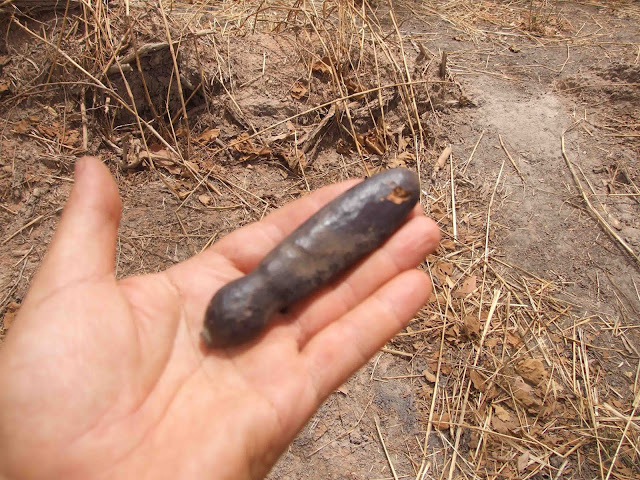 |
| The Pods of Prosopis africana are eaten by cattle. Pounded dry pods are used as a fish poison. |
 |
| The fermented seeds of Prosopis africana are used in some parts of Africa as a food condiment |
 |
| Trunk of Prosopis africana. Commonly known as "ironwood", the wood blunts cutting tools and cannot be nailed without first drilling holes. |
 |
| Cattle in the woodland savannah of Western Bahr El Ghazaal |
 |
| Standing thatch in area flooded during the rains in the moist savannah woodland |
 |
| Moist savannah woodland of Western Bahr El Ghazaal |
 |
| African Mahogany tree (Khaya senegalensis) in the moist wooded savannah of Western Bahr El Ghazaal |
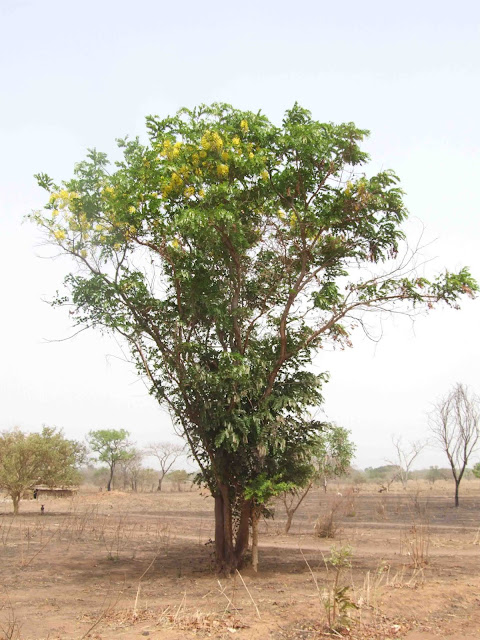 |
| Cassia abbreviata, the "sjambok pod" or long-tail Cassia is native to Africa |
 |
| Fragrant and spectacular yellow flowers of Cassia abbreviata |
 |
| Fragrant flowers of the wild indigenous Gardenia ternifolia |
 |
| Fruit of Gardenia ternifolia |
 |
| Moist savannah woodland cleared and burned for farming in Western Bahr El Ghazaal |
 |
| Hardwood logs of Prosopis africana |
Small Farm Production and Market in Kwajok, Western Bahr El Ghazaal:
 |
| Dinka homestead with Borassus palms (Borassus aethiopium) |
 |
| Run off from hand water pump used to irrigate small plot of Tobacco |
 |
| Green leafy vegetable - Jute (Corchorus olitorius) leaves for sale in Kwajok Market |
 |
| Green leafy vegetable - Cowpea leaves for sale in Kwajok Market |
 |
| Green leafy vegetable - Common Purslane (Portulaca oloracea) leaves for sale in Kwajok Market |
 |
| Fresh fruit and eggs from Khartoum - for sale in Kwajok Market |
 |
| Fresh fish for sale in Kwajok Market |
 |
| Fresh fish for sale in Kwajok Market |
 |
| Poultry sales - Kwajok Market |
 |
| Dried Chilli Pepper for sale in Kwajok Market |
 |
| Dried Okra Powder for sale in Kwajok Market |
 |
| Dried Okra ("Bamia") for sale in Kwajok Market |
 |
| Bitter-sweet fruits of the Desert Date (Balanites aegyptiaca) "Lalop" for sale in Kwajok Market |
 |
| Fresh milk sales in Kwajok Market |
 |
| Transporting two sacks of charcoal to Kwajok Market |
 |
| Charcoal for sale in Kwajok Market |
 |
| Green leafy vegetable - Pumpkin leaves (at rear) for sale in Kwajok Market |
 |
| Fresh Okra ("Bamia") for sale in Kwajok Market |
 |
| Groundnut paste (in foreground) for sale in Kwajok Market |
 |
| Tobacco sales at Kwajok Market |
 |
| Soaked sorghum grains for preparing sorghum beer |
 |
| Malted sorghum grain for sorghum beer brewing |
 |
| Sorghum brew boiled with sugar |
 |
| Butcher in Kwajok Market |
 |
| Kwajok: Collecting "lulu nuts" (Shea butter nut) from Vitellaria paradoxa tree |
 |
| Tobacco and some vegetables being grown next to a flooded borrow pit - irrigation by treadle pump |
 |
| The ApproTEC Super Money maker treadle pump being used to irrigate from the flooded borrow pit |
 |
| Vegetables being grown next to a flooded borrow pit - irrigation by treadle pump |
 |
| Sukuma wiki growing near Kwajok |
 |
| Green pod of Piliostigma thonningii |
 |
| "Camel foot" leaves of Piliostigma (formerly Bauhinia) thonningii |
 |
| Dry black pods of Piliostigma thonningii |
 |
| Mabior Tuot near Kwajok - Vegetable Production supported by NGO with raised water tank and treadle pumps |
 |
| New and old roofing thatch |
 |
| Bundles of roofing thatch (Hyparrhenia rufa grass) for sale in local market |
 |
| Marula tree (Schlerocarya birrea) |
 |
| Leaves and fruit of Marula (Schlerocarya birrea) |
 |
| Fruit of Marula (Schlerocarya birrea) |
Small Farm Production and the Processing of Lulu Nut in Mapel, Western Bahr El Ghazaal:
 |
| Road construction flooded borrow pit suitable for fish farming in Mapel |
 |
| Tobacco Production in Mapel |
 |
| Mapel tobacco production watered from surface well |
 |
| Unimproved (non-grafted) mango tree seedlings, and in foreground drying eggplant crop destroyed by mildew |
 |
| Egg plant, a crop commonly affected by the fungal disease powdery mildew - which in the absence of fungicides, or knowledge of fungicides, is impossible to control |
 |
| Unimproved (non-grafted) mango tree seedlings, |
 |
| Tomato plant affected by leaf curl virus |
 |
| Okra ("Bamia") plant |
 |
| Woodland cleared and burned for "slash and burn" agriculture |
 |
| Compound for Shea nut butter Cooperative in Mapel (in foreground Shea nut tree and screw presses) |
 |
| Fruit of the Shea nut butter tree (formerly Butyrospermum parkii) - Vitellaria paradoxa |
 |
| Grading Shea nut for Quality |
 |
| Grade "A" Shea nut - Cosmetic manufacture quality |
 |
| Lulu nut ovens |
 |
| Lulu nut screw press expeller for expelling oil |
 |
| Bulk container of Lulu nut body lotion |
 |
| Lulu nuts drying in store |
 |
| Lulu nut store - keeping collected lulu nuts dry and free from fungus |
 |
| Old regenerating Burmese teak (Tectona grandis) plantation |
Small Farm Production and Natural Resources in Raffili, Western Bahr El Ghazaal
 |
| Transportation of Charcoal to market for sale |
 |
| Transportation of grass thatching straw to market for sale |
 |
| FAO Farmer Field School (FFS) in Bazia |
 |
| FFS Sugar cane plantation with sugar cane suffering effects of lack of water |
 |
| Borassus Palm (Borassus aethiopium) with fruit |
 |
| Edible Fruit of Borassus Palm (Borassus aethiopium) |
 |
| Brick Kiln (note log of Ironwood "Amsaruch" (Prosopis africana) used to fuel kiln |
 |
| Greyish Eagle Owl (Bubo cinerascens) at Bazia |
 |
| Small backyard Burmese Teak (Tectona grandis) Plantation - Cut by soldiers |
 |
| Net fishing in a tributary of the Jur river |
 |
| Hollowed out Borassus Palm log fishing canoe |
 |
| Net fishing at Bussera |
 |
| Water Melon and Pineapple in Jur river irrigation farm |
 |
| Future guard dogs at Jur river irrigated farm |
 |
| Capsicum (Sweet Pepper) at Jur river farm |
 |
| Cassava nursery at Jur river farm |
 |
| Onions at Jur river irrigated farm |
 |
| Tomatoes at Jur river irrigated farm |
 |
| "Amsaruch" (Prosopis africana) pods collected for use as fish poison |
 |
| Jur river Cattle |
Small Farm Production and Natural Resources in Raja, Western Bahr El Ghazaal
 |
| Pounding Sorghum Grain at Fongo Fishing Camp |
 |
| Fisherman at Fongo with woven palm leaf fish trap and fishing net |
 |
| West African Fulani herdsmen with Cattle in forest - around 50 km from Raja |
 |
| Raja - Improved fired brick - built grain store with protection against climbing rodents |
 |
| Crocodile Skin Sourced from Central African Republic |
 |
| Python Skin - Sourced from Central African Republic |
 |
| Python Skins - Sourced from Central African Republic On 06.03.2018 South Sudan banned all forms of wildlife hunting and trade in wildlife products. Transgressors face a 2-year jail term or fines |
 |
| Trader with large quantities of bees wax - Sourced from forest honey gatherers |
 |
| Trader with bulk honey - Sourced from forest honey gatherers |
 |
| Trader selling mint (for adding to tea) in Raja Market |
 |
| Tea bar in Raja Market - with wide variety of hot drinks |
 |
| Petrol Station in Raja Market - Petrol Sales in Plastic bottles made illegal after independence |
 |
| Raja Market - Mint Leaves for use in Tea |
 |
| Tomato Sales in Raja Market |
 |
| Sales of Common Purslane (Portulaca oloracaea) in Raja Market |
 |
| Cooking oil and onions for sale in Raja Market |
 |
| White Egyptian radish (Raphanus sativa) for sale in Raja Market |
 |
| Butcher in Raja Market |
 |
| Tomato, Jute, Spring Onion and White Radish for Sale in Raja Market |
 |
| Cowpea leaves for Sale in Raja Market |
 |
| Sweet-smelling Acacia nilotica Pods - Cough remedy in Raja Market (note exit holes of Bruchid seed Beetles) |
 |
| Sour pods of Tamarind (Tamarindus indica) for Sale in Raja Market |
 |
| Red beans - sourced from the World Food Programme - for sale in Raja Market |
 |
| Washed and dried Coffee Beans for Sale in Raja Market |
 |
| Typical Market Stall in Raja Market |
 |
| Ginger Rhizomes for Sale in Raja Market |
 |
| Garlic Cloves for Sale in Raja Market |
 |
| Dried Dates for Sale in Raja Market |
 |
| "Artrun" Mineral Supplement for Ruminants for Sale in Raja Market |
 |
| Collected Bitter-sweet fruit of "Lalob" Desert Date (Balanites aegyptiaca) for Sale in Raja Market |
 |
| Typical Product Range on General Market Stall in Raja Market |
 |
| Charity Water jars - free drinking water - in Raja Market |
 |
| "Karkadey" Hibiscus tea - Hot sweet/sour drink (with mint) - prepared from stewed flowers of Roselle (Hibiscus sabdariffa) |
 |
| The Roselle (Hibiscus sabdariffa) - fleshy sepals of the flowers used to make "Karkadey"- hibiscus tea |
 |
| The Roselle (Hibiscus sabdariffa) - fleshy sepals of the flowers used to make "Karkadey"- hibiscus tea |
 |
| Hot Beverage Sales in Raja Market - note all the tins for condiments and spices |
 |
| Charcoal Sales in Raja Market |
 |
| Thatching grass, woven grass mat fence and building poles for Sale in Raja Market |
 |
| Borassus palm roofing poles for Sale in Raja Market |
 |
| "Amsaruch" (Prosopis africana) hardwood roofing poles cut from the forest - for Sale in Raja Market |
 |
| Bamboo building poles for Sale in Raja Market |
 |
| "Seybay" Construction Poles for Sale in Raja Market |
 |
| "Habil" Poles for Sale in Raja Market |
 |
| "Kofu" Construction Poles for Sale in Raja Market |
 |
| "Ambulutu" Construction Poles for Sale in Raja Market |
 |
| Bundle of Unidentified Construction Poles cut from the forest - for Sale in Raja Market |
 |
| Wicker basket tree seedling protector - for Sale in Raja Market |
 |
| Thatching grass, woven grass mat fence, charcoal and building poles - for Sale in Raja Market |
 |
| Horse and Cart for Transportation of Goods in Raja Market |
 |
| Groundnuts - One of two Varieties for Sale in Raja Market |
 |
| Groundnuts - One of two Varieties for Sale in Raja Market |
 |
| Rock Salt for Sale in Raja Market |
 |
| Small restaurant business in Raja Market |
 |
| Pumpkins for Sale in Raja Market |
 |
| Gourds for Sale in Raja Market |
 |
| Gourds + basket for household drinking water storage - for Sale in Raja Market |
 |
| Dried Tomato - sourced from Darfur - for Sale in Raja Market |
 |
| Dried Okra and Salt Merchants in Raja Market |
 |
| Selling Nigerian Body lotion in Raja Market |
 |
| Veterinary retail outlet in Raja - Significant sales of trypanocides to Fulani herdsmen who pass through tsetse-infested areas in the forest close to Raja |
 |
| Fulani sheep being offered for sale in Raja Livestock Market |
 |
| 4-Year old Fulani sheep ram being sold in Raja Livestock market |
 |
| The tunnelling leaf damage of the larva of the moth (Lepidoptera: Gracillaridae) Citrus Leaf miner (Phyllocnistis citrella) pest on grapefruit leaf |
 |
| Gummosis (Phytophthora fungus) disease in mature grapefruit tree (seedling brought from Khartoum) |
 |
| The author operating a traditional irrigation "Shaduf" - ancient traditional irrigation technology from Sudan |
 |
| The author operating a traditional irrigation "Shaduf" - the only one seen while travelling in Greater Bahr El Ghazaal |
 |
| Water raised from river to irrigation channel with a "Shaduf" |
 |
| Shaduf-irrigated "khudra" or flax (Corchorius olitorius) |
 |
| Guard House being Constructed for the Red Crescent Organisation (note hardwood lintels above windows/door) |
 |
| "Bulta" Tilapia (Oreochromis nilotica) for Sale in Raja Market |
 |
| Watermelon - sourced from Sopo - for Sale in Raja Market |
 |
| Raja Livestock Market |
 |
| Fulani Cattle for Sale to Butchers in Raja Livestock Market |
 |
| Early Morning at the Raja Livestock Slaughter Slab |
 |
| Post-Mortem Lymph Node Examination at Raja Slaughter Slab |
 |
| Carcasses being skinned/dressed at Raja Slaughter Slab in early morning |
 |
| Post-Mortem Veterinary Inspection at Raja Slaughter Slab |
 |
| Early Morning Slaughter of Bull at Raja Slaughter Slab |
 |
| Dressed Carcasses at Raja Slaughter Slab |
 |
| Unusual, unmistakeable long tailed crow - the Piapiac (Ptilostomus afer) attracted to Offal at Raja Slaughter Slab |
 |
| Lung condemned after post-mortem inspection |
 |
| Dressed Carcasses for Collection by Local Meat Retailers in Raja Market |
 |
| Dried Cattle Hides at Raja Slaughter Slab |
 |
| Gourd Vine in tree near Raja |
 |
| "Umbuluto" Fruit Tree near Raja |
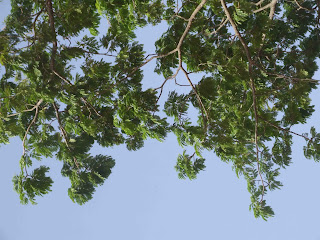 |
| Foliage of "Umbulutu" Fruit Tree |
 |
| Trunk of "Umbulutu" Fruit Tree |
 |
| Fruit of "Umbulutu" tree |
 |
| Fulani donkeys and Cattle in tsetse-infested forest about 50 km from Raja |
 |
| Borrow Pit full of water - potential for fish farming |
 |
| Improved Grain Store Constructed by NGO ACTED |
 |
| Inside ACTED Improved Granary |
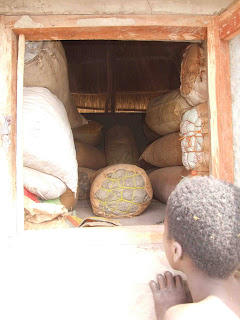 |
| Inside ACTED Improved Granary |
 |
| Legs of Granary Protected from Climbing Rodents with Inverted Steel Bowl |
 |
| Legs of Granary Protected from Climbing Rodents with Inverted Steel Bowl |
 |
| Chicken Coop to Protect Chickens from Nocturnal Predators |
 |
| Mud brick - Constructed Improved Granary |
 |
| Mud brick - Constructed Improved Granary |
Small Farm Production and Natural Resources in Tonj, Western Bahr El Ghazaal
 |
| Women waiting for Well to recharge between Kubrisac and Kuajiena |
 |
| Open Storage/Sun-drying of Dhurra Pannicles |
 |
| Open Storage/Sun-drying of Dhurra Pannicles |
 |
| White and Red Sorghum in Open Storage |
 |
| Yellow Maize Cobs Stored/Sun-dried in Open on Tree |
 |
| Yellow Maize Cobs Stored/Sun-dried in Open on Tree |
 |
| DDR Participant Interview at Homestead |
 |
| Bundles of grass (Hyparrhenia rufa) thatch for Sale at the side of the road |
 |
| Unidentified "Abu Kamira" fruit |
 |
| Plane Crash beyond Tonj Airstrip |
 |
| Shallow well irrigation near Jur River at Tonj |
 |
| Shallow well irrigation near Jur River at Tonj |
 |
| Small Chinese-Manufactured Water Pump for Shallow well irrigation near Jur River at Tonj |
 |
| "Khudra" or Jute Production at Tonj (note hedge of the Poisonous "bio-diesel" plant: Jatropha curcas |
 |
| Jute (Corchorus olitorius) grown as a leafy vegetable at Tonj |
 |
| Lister-Petter Diesel Water Pump irrigating from the river Jur at Tonj |
 |
| Nur River at Tonj |
 |
| Irrigation Pipes - River Jur at Tonj |
 |
| Hedge of the "bio-diesel" plant Jatropha curcas |
 |
| Jatropha curcas hedge to irrigated farm at Tonj (note cluster of Jatropha fruit) |
 |
| Fruit and oil-seed of the Poisonous Bio-diesel Plant Jatropha curcas |
 |
| The Seed of Jatropha curcas - that can be crushed for extraction of oil (bio-diesel) |
 |
| Brick Kilns and the huge quantity of hardwood fuel logs (of principally Prosopis africana) used to fire the bricks |
Small Farm Production and Natural Resources in Wau, Western Bahr El Ghazaal
 |
| Garden Centre - Tree seedling Sales in Wau Town |
 |
| Tree Seedling Sales in Wau Town |
 |
| Vegetable Sales in Wau Town |
 |
| Grapefruit from Khartoum - Fruit Sales in Wau Town |
 |
| Limes from Khartoum - Fruit Sales in Wau Town |
 |
| Capsicum from Khartoum - Vegetable Sales in Wau Town |
 |
| Carrots and Cabbages from Khartoum - Vegetable Sales in Wau Town |
 |
| Donkey Cart Water Seller - Wau Town |
 |
| Shallow Well near River for Irrigation - Wau Town |
 |
| Diesel irrigation pump - Wau Town |
 |
| Irrigated "Figil" Egyptian White Radish (Raphanus sativa) |
 |
| Jur River Irrigated Farm at Wau |
 |
| Irrigated Tomato Production in Wau |
 |
| Tomato affected by Sun-Scald - loss of leaves due to fungal disease - Wau Tomato Production |
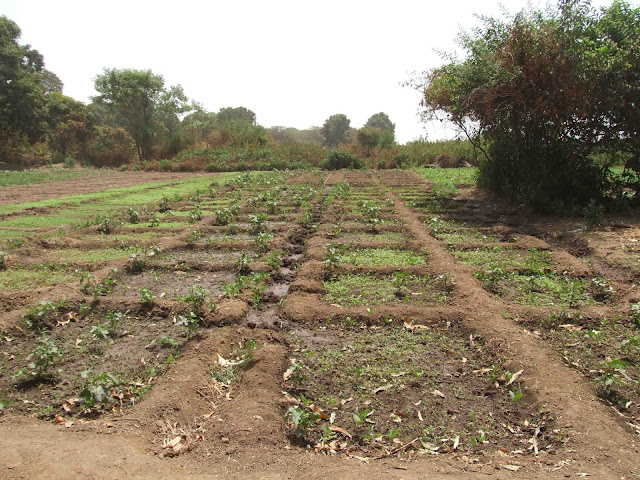 |
| Jur River Irrigated Farm, Wau |
 |
| Irrigation water intake pipe - Jur river farm, Wau |
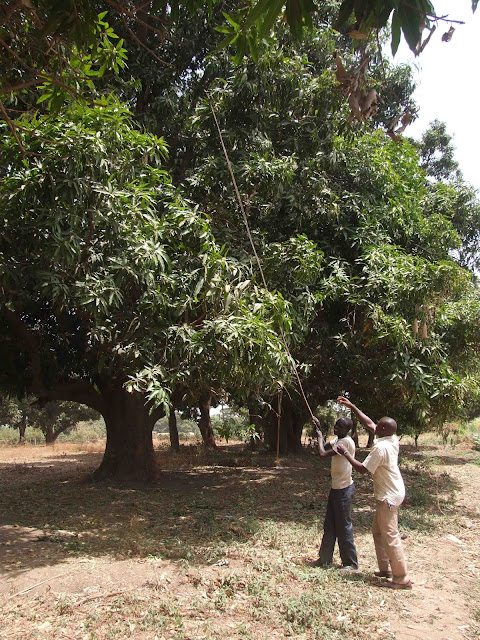 |
| Harvesting Mango in Wau |
 |
| Red Melon Beetle (Aulacophora africana) - Pest of "Figil" White Egyptian Radish |
 |
| Red Melon Beetle (Aulacophora africana) - Pest of "Figil" White Egyptian Radish |
 |
| Skeletonising damage to leaves of Egyptian White Radish (Raphanus sativa) caused by Red Melon Beetle (Aulacophora africana) |
 |
| Luffa aegyptiaca vine - the fruit ("Loofah" or "Luffa") is edible when small, but quickly becomes fibrous |
 |
| Mature fibrous "Luffa" fruit - useful as a back scrubber |
 |
| Drying Okra and Okra Leaves |















No comments:
Post a Comment